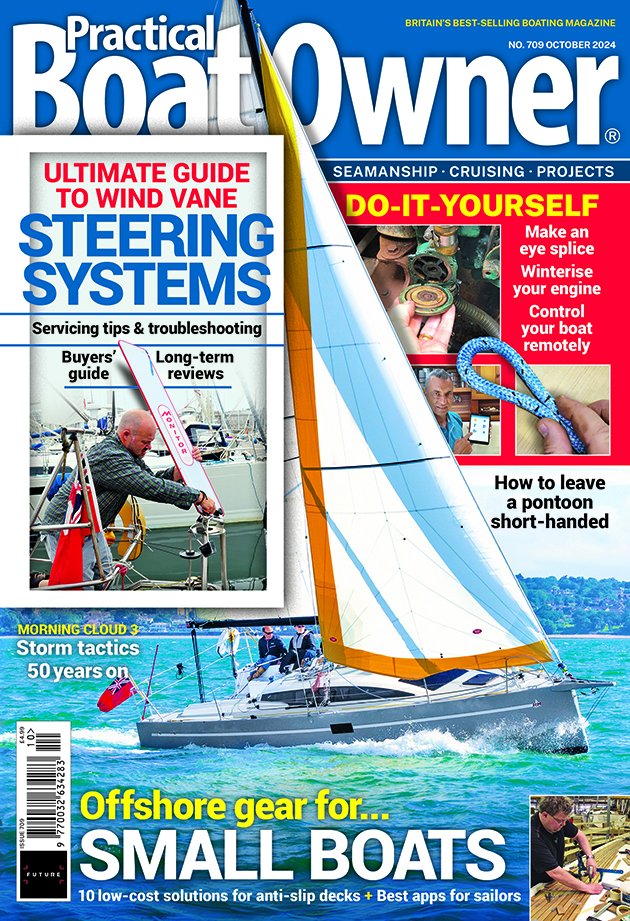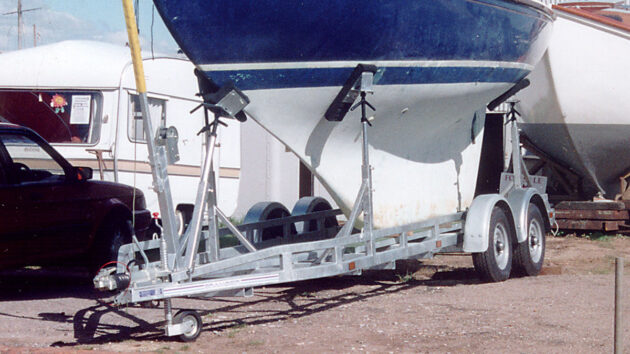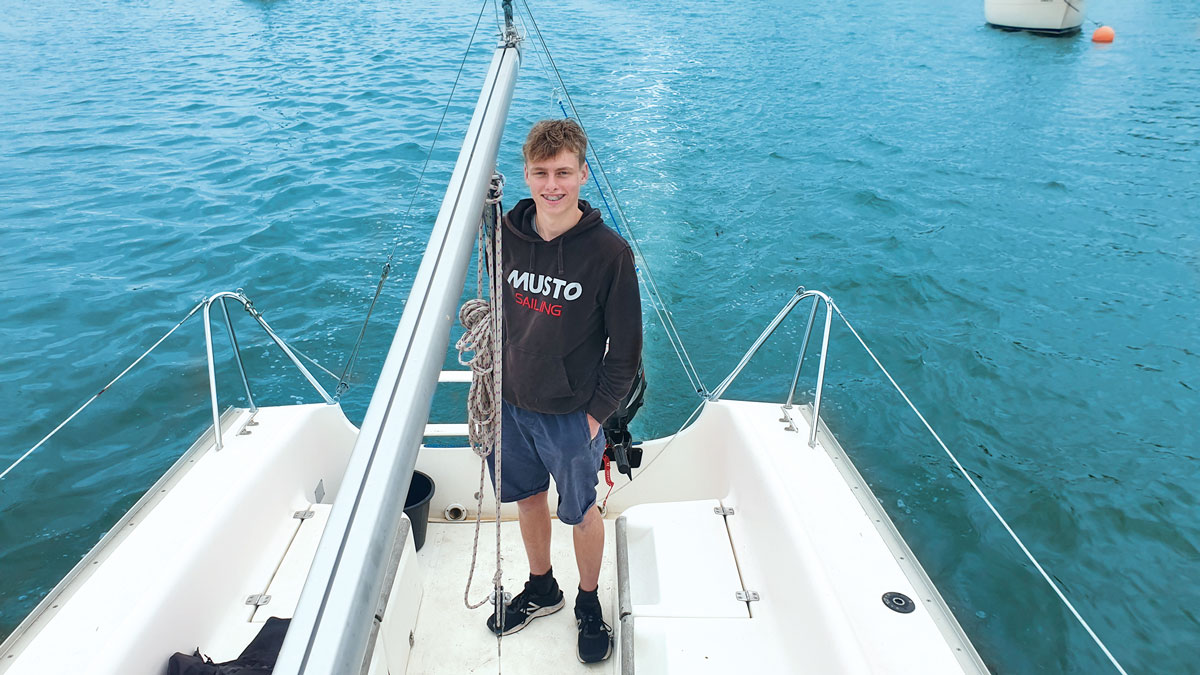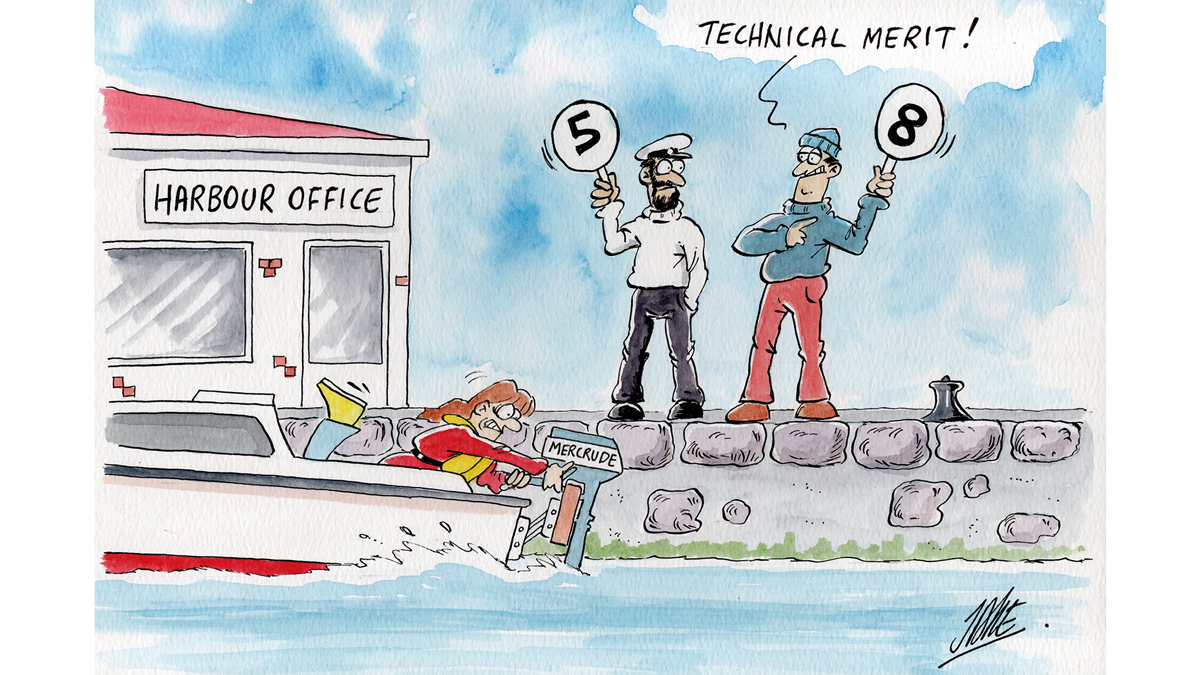Tony Davies advises on what to look out for when buying a used boat trailer
When the boating budget is tight there are superficially compelling financial reasons for considering the purchase of a used boat trailer
Unfortunately, however, it is all too easy to buy a trailer that is either not suited to the boat, under-specified in carrying capacity or just poorly built.
It must always be remembered that a trailer is a road vehicle, and it will be carrying probably your most treasured possession.
If it fails, it will not only seriously damage the boat, but may also cause a major road accident.

Make sure the trailer you buy is suitable for your boat
On the surface, a trailer appears to be a pretty simple piece of kit; nothing more than a chassis on one or more axles with a set of brakes plus some supports for the boat.
However, the design of a good trailer as opposed to a bad one is more complex than it first appears.
Attention is given to the torsional stability of the chassis frame itself, the position of the axle/s and winch post in relation to the weight distribution of the boat and the method of supporting the boat evenly along the length of the hull.
Buying a used boat trailer: Nose weight
The first point to bear in mind when looking at potential trailers is how the boat will sit on it and the weight distribution once the boat is in its proper position.
These are the factors that will affect the nose weight bearing down onto the tow ball of the towing vehicle.
Acceptable nose weight varies from vehicle to vehicle and should be checked with the manufacturer.
If the nose weight is too high, the front wheels of the towing vehicle will have less road contact, affecting steering and vehicle stability.
With too little nose weight, the vehicle’s rear wheels will lose traction.
Either scenario can cause snaking between the trailer and tow vehicle, which if not properly and quickly overcome can lead to total loss of control.
Modern trailers for trailer sailers with lifting keels are generally equipped with ‘rollercoaster’ supports that consist of rows of relatively soft small-diameter wheels that not only make loading easy, but also spread the load over a wide area of the hull.
It is also possible to have additional supports along the length of the keel when extra support is required.
The special requirements of other hull shapes (such as round-bilge) can be generally accommodated using keel rollers and chine supports rather than ‘rollercoasters’.
It is certainly easier to find a used boat trailer to fit a hard-chine hull than, for example, a fin-keeled yacht that needs a particularly carefully designed trailer to ensure its safety when on the road.
Buying a used boat trailer: Gross weight
Another point to bear in mind, and one which is particularly important, concerns the gross weight of the boat.
If the boat is to be towed in cruising trim with all the equipment normally kept on board, then its all-up weight will be significantly higher than the manufacturer’s quoted displacement for the bare boat.
The gross weight of the boat should ideally be checked before a trailer is purchased, although in many cases this is impractical.
Once the boat is on the trailer it can be easily be weighed by taking it to a council weighbridge.
The weight of the trailer, as shown on the maker’s plate, can then be deducted.
If there is no manufacturer’s plate, the trailer is either very old or an amateur-built job – which will mean taking the trailer back to the weighbridge empty and weighing it on its own.
Of course, at this stage, it may be found that the trailer is under-specified for the weight of the boat in cruising trim.
For this reason, when looking at a used boat trailer – or a new one, come to that – it is always best to err on the side of caution when considering the gross weight
of the boat and therefore the capacity of the trailer required.
Once all the theory has been worked out, it is then just a matter of looking round until a suitable trailer is offered and then examining it for the many obvious and not-so-obvious faults that are to be found with used boat trailers.
What to look at when buying a used boat trailer
Wheels and tyres
The wheels and tyres need to be of heavy enough construction for the capacity of the trailer, but this is difficult if not impossible to assess accurately. Additionally, the wheels should not show signs of excessive corrosion.

1. This wheel looks relatively sound but, if you look carefully, two wheel studs are broken off, indicating possible previous misuse and certainly a lack of proper maintenance.
The remaining studs need checking to ensure the threads are sound before taking the trailer home, and the broken studs will need replacing at the earliest opportunity.
Similarly, the bearing housing covers are missing, which is likely to mean that the wheel bearings will be worn due to dirt and water ingress.
For safety’s sake, the bearings should be renewed at the earliest opportunity, and new covers should be fitted.

2. Check the condition of the wheel bearings before taking the trailer home.
Jack it up until the wheels can be turned freely, then rock each wheel from top to bottom and side to side.
There should be a barely perceptible movement in each direction to show the bearings are properly adjusted, with enough free play to prevent overheating.
Spin each wheel and listen to the bearings. They should spin with no appreciable noise.
If there is a crackling, crunching noise from the bearings this indicates that the rollers or balls in the bearings have started to break up.

3. A trailer in good condition will have steel-belted radial tyres of the correct rating, all bearing covers properly in position and all studs and nuts tight and clean.

4. The tyres themselves should be in good condition: this example, with cracks in the wall, would probably fail an MOT test if fitted on a car, so they are equally unsuitable on a road-going trailer.
Note also the proximity of the mudguard to the tyre, which severely restricts movement of the suspension unit before contact is made between tyre and the mudguard.
New tyres, and those in good condition, will show no signs of damage or excessive wear
Coupling and brakes

1. The type of brake coupling gives a good indication of the age of the trailer.
This old-type over-run coupling, while still being legal for road use on older trailers, has not been fitted on newer trailers for some time.
This type of coupling will only work with matching, old-style brakes.
Modern auto-reversing braked hubs cannot be used with this type of coupling: similarly, auto-reverse couplings will not work with early over-run-type braked hubs.
While many old-style parts are still available as spares, if any substantial part of the braking system needs replacing with modern parts, the whole system must be replaced.

2. Check the braking system generally to ensure it works.
Test for free movement of all the rake components from coupling to hubs.

3. Note the narrow nose of this trailer design.
The modern coupling shown is much wider, and means the trailer would need to be modified before a modern coupling could be fitted.

4. Old-style over-run couplings have a flip-over latch which must be engaged before the trailer can be reversed.
Modern auto-reverse couplings work automatically and release the brakes while reversing.
Chassis assembly checks

1. A maker’s plate displays the provenance of the trailer and its rated capacity.
No maker’s plate means the trailer was either amateur-built or is very old.
Without this plate, the capacity of the trailer can only be estimated, and it is likely that the trailer will have been overloaded in the past.

2. This trailer is built of single-run channel section which has very little torsional strength and allows the trailer to flex and twist quite dramatically when loaded.
This imparts stress on the welded joints and may lead to weld failure.
A trailer built of single-run channel section with no additional stiffeners is not a good buy

3. Box sections offer the greatest stiffness and avoid twisting, while double- or triple-run sections prevent flexing lengthways.

4. When axles are clamp-bolted to the chassis, adjustment for weight distribution is simple.
It usually only takes a small movement to provide the necessary adjustment.

5. Welded axles allow no opportunity to adjust the balance of the trailer to suit a particular boat.

6. Corrosion anywhere on the trailer needs careful attention. The base of this winch stay is showing signs of corrosion and will need removing and treating before painting and refitting.
On this particular trailer, the central channel section on which it is mounted twists easily and offers almost no lateral support to the bow of the boat.
Winch and rollers checks

1. A properly designed trailer has a rigidly mounted winch stay that supports the bow of the boat and allows it to be winched up tight against the stay.

2. A modern winch is easy to operate and runs smoothly. It is also matched to the capacity of the trailer for hauling the boat into position.

3. This winch has obviously been over-strained at some time and will need immediate replacement as it is dangerous to use in its current condition.
Rust and lack of lubrication mean early failure.

4. Single large-support wheels concentrate the load on one area of the hull, although the main weight of vessel is on the keel rollers.

5. A frayed, rusted and kinked winch cable like this is an accident waiting to happen.
The carbine hook has been over-stressed and is permanently open and likely to break when under pressure.
The webbing on a modern winch with a webbing strap is clean and safe to handle, and the hook on the end is matched to the winch to avoid over-straining.

6. ‘Rollercoaster’ wheels spread the load over a much wider area of the hull, and the main weight can either be taken on the keel or the hull area supported by the rollercoasters, or a mix of both.
Conclusion
Buying a dodgy used boat trailer could mean the end of your boat. Is it worth the worry when new trailers cost a small percentage of the value of the boat?
Easy to say, I know, when a lot of us do our boating on a very tight budget, and sometimes new is just beyond our reach.
There are good second-hand trailers about – but if you want to achieve any resale value, ensure you buy one with a modern design and a proper maker’s specification plate.
This goes a long way to ensuring it has been properly designed for boat work and provides an unambiguous guide to its rated carrying capacity.
“How I restored my Jeanneau Sun 2000 trailer-sailer at the age of 15”
Jack Gore was just 10 when he became smitten with Victoria. He explains how he turned a neglected Jeanneau Sun…
How to replace boat trailer leaf springs
Steve Walburn replaces his boat trailer leaf springs
The best trailer sailer boats for weekend cruising… or longer
Duncan Kent reviews a selection of new and used trailer sailer boats that are large enough to accommodate crew for…
How to launch a trailer sailer (and the key mistakes to avoid)
George was helping to launch his friend’s boat and asked if Paul and I could give them a hand. My…
Want to read more practical articles like Tips for buying a used boat trailer?

A subscription to Practical Boat Owner magazine costs around 40% less than the cover price.
Print and digital editions are available through Magazines Direct – where you can also find the latest deals.
PBO is packed with information to help you get the most from boat ownership – whether sail or power.
-
-
-
- Take your DIY skills to the next level with trusted advice on boat maintenance and repairs
- Impartial in-depth gear reviews
- Practical cruising tips for making the most of your time afloat
-
-
Follow us on Facebook, Instagram, TikTok and Twitter








